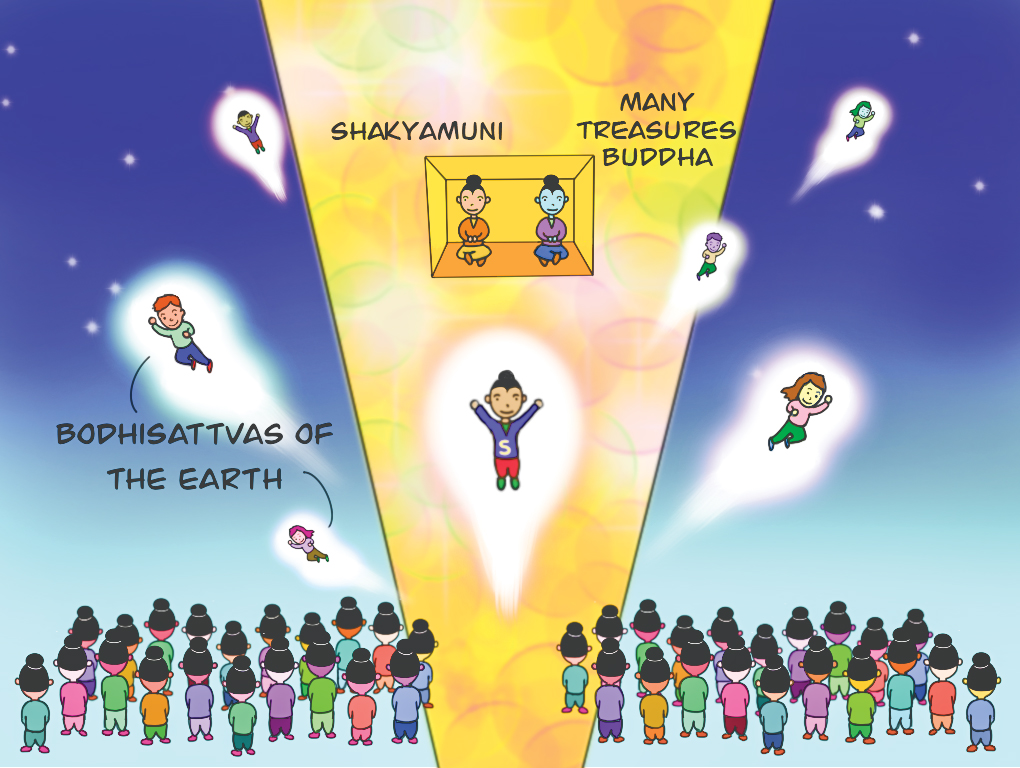The drama that unfolds in the 28 chapters of the Lotus Sutra is described by SGI President Ikeda as “a movie on a truly colossal scale projected on the screen of the whole universe” (The Wisdom of the Lotus Sutra, vol. 1, p. 66). The drama of this “movie” transcends space and time, depicting many stories that are set in various lands throughout the universe that tell of Shakyamuni Buddha’s lives in the remote past, as well as a time far beyond his death.
The central themes of this story are of Shakyamuni’s awakening to the eternal life state of Buddhahood that exists not only within himself but also in the lives of all people and how he entrusted the task of continuing to awaken everyone to this Buddhahood far into the future.
This “movie” can be divided into three major scenes.
The first is set on Eagle Peak, and it starts with “Introduction” and ends with “The Teacher of the Law,” the 10th chapter. This is where Shakyamuni begins preaching the Law.
The scene changes at the beginning of “The Emergence of the Treasure Tower,” the 11th chapter, when an enormous treasure tower suddenly rises up from the earth and into the air. Shakyamuni Buddha and Many Treasures Buddha are seated together within the tower, and the assembly is lifted into the air as the preaching resumes. This Ceremony in the Air continues until “Entrustment,” the 22nd chapter. In the 23rd chapter, “Former Affairs of the Bodhisattva Medicine King,” the scene returns to Eagle Peak and remains there through the last chapter, “Encouragements of the Bodhisattva Universal Worthy.”
The Treasure Tower Symbolizes the Infinite Nobility of Our Lives
Of the three scenes, the Daishonin particularly emphasized the Ceremony in the Air, which he expressed as the Gohonzon, the object of devotion for the sake of all humanity.
In the sutra’s 11th chapter, the Ceremony in the Air begins after the enormous treasure tower, standing at a height one-third to one-half the Earth’s diameter, emerges from beneath the earth and is suspended in midair. It is embellished with seven kinds of treasures and jewels, which signify the beauty, grandeur and dignity of human life.
President Ikeda says: “That colossal treasure tower is an expression of the state of Buddhahood that lies dormant within each of us. It teaches us the infinite nobility of life” (The Wisdom of the Lotus Sutra, vol. 1, p. 93).
Shakyamuni opens this treasure tower, and the already seated Many Treasures Buddha invites him to take a seat next to him. Then, he uses his transcendental powers to lift the entire assembly up to the same level as himself, exhibiting the spirit of equality and humanism of the Lotus Sutra and Nichiren Buddhism.
Nichiren Daishonin often compared the Gohonzon to the treasure tower, emphasizing that it exists in the lives of those who believe in the Mystic Law and chant Nam-myoho-renge-kyo. In a writing to his disciple Abutsu-bo, he states:
In the Latter Day of the Law, no treasure tower exists other than the figures of the men and women who embrace the Lotus Sutra. It follows, therefore, that whether eminent or humble, high or low, those who chant Nam-myoho-renge-kyo are themselves the treasure tower . . .
Abutsu-bo is therefore the treasure tower itself, and the treasure tower is Abutsu-bo himself. No other knowledge is purposeful. (“On the Treasure Tower,” The Writings of Nichiren Daishonin, vol. 1, p. 299)
In another writing, Nichiren refers to the two Buddhas seated side-by-side in the treasure tower, stating:
This mandala is in no way my invention. It is the object of devotion that depicts Shakyamuni Buddha, the World-Honored One, seated in the treasure tower of Many Treasures Buddha, and the Buddhas who were Shakyamuni’s emanations as perfectly as a print matches its woodblock. (“The Real Aspect of the Gohonzon,” WND-1, 831)
In other words, no matter where we are, by chanting to the Gohonzon and practicing for the happiness of ourselves and others, the place where we are is where the treasure tower emerges, enabling us to bring forth the greatest life state of Buddhahood.
“Please Join Me” in Spreading the Law
The Ceremony in the Air is not a historical event or a fantastical Buddhist tale. In essence, it can be viewed as a metaphor for the emergence of our innate Buddhahood, the potential in all people to bring forth supreme compassion, courage and wisdom.
In addition, as President Ikeda writes in his recent message to the SGI-USA Central Executive Committee:
Nichiren declares: “You should respect one another as Shakyamuni and Many Treasures did at the ceremony in the ‘Treasure Tower’ chapter” (“The Fourteen Slanders,” WND-1, 757).
After the treasure tower rises from the earth, its doors open and Many Treasures Buddha offers the seat beside him to Shakyamuni, saying, “Please join me” . . . Using this as a prime example, Nichiren is teaching us the importance of respecting and treasuring one another as we advance toward kosen-rufu and the eternal perpetuation of the Law. (Oct. 18, 2019, World Tribune, pp. 6–7)
We learn from the respect expressed by Many Treasures and Shakyamuni in the Ceremony in the Air that the key to a peaceful future for humanity lies in our genuine efforts to respect, appreciate and value each person. Fostering mutual respect through heartfelt dialogues can bring about deeper, more meaningful friendships that support the flourishing of peace and the eternal perpetuation of the Law.
You are reading {{ meterCount }} of {{ meterMax }} free premium articles

